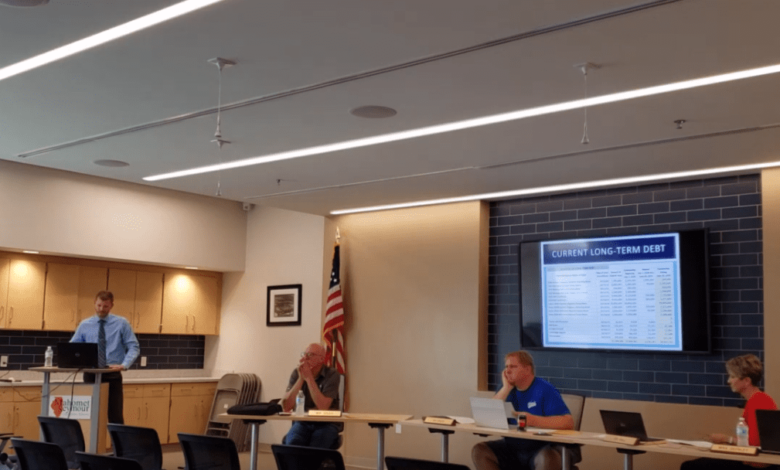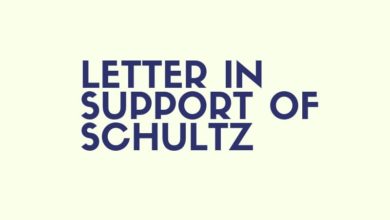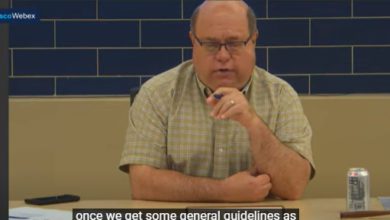Mahomet-Seymour Finance Committee gets first look at proposed budget

BY DANI TIETZ
dani@mahometnews.com
Mahomet-Seymour Policy Committee: We have not had a chance to write about this policy meeting. This meeting happened on August 12, 2019.
Mahomet-Seymour Finance Committee
The Mahomet-Seymour Finance committee, board members Ken Keefe and Merle Giles, heard a preliminary outline of the FY 2020 budget from Chief School Business Official Trent Nuxoll and Superintendent Lindsey Hall on Thursday, Aug. 15.
Nuxoll said the FY 2019 ending fund balance is representative of the district not receiving the property tax payment from the county because property tax bills were sent late.
“The beginning fund balance from last year, which we know from July financial update ended pretty poorly with the lack of second-largest payment of FY ‘19 property tax cycle.
“So we did end the year with some negative fund balances,” Nuxoll said.
As of July 1, 2019, the educational fund ended at minus $302,778.97, the operations and maintenance fun ended at minus $323,572.07, the debt service fund ended at $913,747.82, the transportation fund ended at $113,882.11, the IMRF fund ended at minus $70,309.79, the capital projects fund ended at $550,675.96, the TORT fund ended at $376,182.48 and the life safety fund ended at $332,210.64.
Nuxoll said in 2019, the Mahomet-Seymour School District saw a 7.35-percent increase in EAV. He said he took a conservative approach, expecting a 4-percent increase in EAV in the upcoming year.
Giles said there had been years where the increase was 1- to 2-percent.
Nuxoll said, “in years when (the EAV) would get down to 3-percent, we would still be conservative and assume half that.
“I think going into next year, especially with all the construction we are seeing in the community, 4-percent is pretty safe.”
The district projects $41,498,810.75 in revenue with $37,083,546.91 expenditures in FY 2020.Projected increases the district will face in FY 2020 are scheduled Mahomet-Seymour Education Association raises, several staff changes and added positions, $148,000 for sixth- and ninth-grade Chromebooks and $107,000 for textbook adoption.
Mahomet-Seymour was designated in Tier 1 funding for the 2019-2020 school year. During the FY 2018 and 2019, the district received Tier 2 funding.
Being designated as a Tier 1 school district, Mahomet-Seymour will see an additional $509,000 in FY 2020.
Some of the increases, such as the Mahomet-Seymour Junior High Library Aide ($31,737.91), a kindergarten teacher at Middletown Prairie Elementary ($71,389.50), a first-grade teacher at Middletown Elementary ($50,276.42), a teacher to fill a fifth special at Middletown Prarire Elementary ($62,253.36), a Mahomet-Seymour High School guidance counselor ($73,063.24), a coordinator of student services ($12,524.61), furniture for additional first- and second-grade classrooms at Middletown Prairie ($21,689.73) and ABL/5th special smartboards ($8,573.00) will be covered with Educational-Based Funding from the State of Illinois.
Hall said the increase of enrollment triggered the hiring of the two teachers at Middletown Prairie.
“We were really close, and just felt, at that time, that it was better to add,” she said.
The additional of the two classes made it necessary for the district to purchase additional furniture and smartboards for those classrooms.
The fifth special discussion occurred in the Spring of 2019 when the district looked at how it could best serve the social and emotional needs of its youngest students.
With the retirement of a counselor from Middletown Prairie in 2019, the district looked at whether or not to replace that position or create a fifth special that would serve those students.
Hall said the other reason for the additional position was to “loosen up the master schedule” in Middletown Prairie.
“The enrollment, the number of sections and the size of the building itself were driving some of that conversation,” she said.
The trade-off from not replacing the guidance counselor at Middletown was that Mahomet-Seymour High School and Junior High would get an additional counselor to serve those students.
Hall said that that need for an additional counselor for the teen-aged students had been on the table since she came in 2017.
It had been a vacancy from 2010-2011 the district decided not to replace a retiring guidance counselor in lieu of budget cuts.
“Our two counselors at the high school have absorbed all that work plus taken on the increase in enrollment,” Hall said.
Hall also said the junior high and high school library aide position will help to ease some of the burden on the librarians serving those schools.
“We have library aides here at Middletown and Lincoln Trail,” she said. “Just with the growth of our population as well as the technology that has been infused into the buildings, they needed some support and help.”
Hall said that the starting point for the discussions are held within the district’s leadership team as they identify needs throughout the district.
“I also want to make clear that there are a list of needs, and unfortunately we can’t do everything,” she said. “There’s some prioritizing discussion that goes with that to figure out where we can have the highest leverage and make the most impact.
“We’re already starting to talk about what we need looking forward to 2021.”
Giles wanted to know if Hall could recall where the district added teachers over the last few years.
Nuxoll said last year they added a kindergarten and fourth-grade section.
“That created 10 sections of fourth grade, and that position moved up to fifth grade so that there are now 10 sections of fifth grade,” Hall said.
Giles asked how many kindergarten classes there were in 2018 and 2019.
Hall said there were 11 in 2019 and there are 12 in 2019.
Giles questioned when the district might run out of classrooms within the Middletown Prairie building.
“We have a couple spare classrooms,” Hall said.
Hall said that when the district adds a class, that means that there was an increase of 20 to 22 students in a grade.
Mahomet-Seymour Junior High saw an increase of 30 total students as of the Thursday afternoon meeting. Six-day numbers, what the district reports to the state, will be established with enrollment on Friday.
Keefe asked which of the positions listed had been hired.
Hall said all of the positions had been hired and began to work.
“And the furniture and smartboards have been purchased?” Keefe asked.
Nuxoll said that smartboards were purchased a couple weeks ago, and the furniture was ordered on Thursday.
“The thing that strikes me, that I’m a little confused about is these decisions were made prior to our finding out that we have this Tier 1 funding,” Keefe said.
“So if the Tier 1 funding had not gone through, was this already slotted into the existing budget?”
Nuxoll said that among Superintendent meetings, the district believed that they would receive at minimum Tier 2 funding.
Under the Tier 2 funding in FY 2019, the district received $250,000.
“We felt very confident we would at least get that,” Nuxoll said.
Hall said the difficultly in planning for state funding is that districts statewide don’t know their funding Tier until Aug. 5.
She said that jumping on hiring the new classroom teachers was important because of the teacher shortage being experienced statewide.
“We interviewed three people for the kindergarten and first-grade position,” she said. “The complicating factor here, and we were seeing this last spring, as well, although I think it is getting worse as you go into the summer, is that we are experiencing a dire teacher shortage.
“And when you work in Mahomet-Seymour and we’re seeing the small candidate pools that we’re seeing, we know that it’s a whole lot worse in other places.
“We are thankful that we found really excellent people to fill these positions,” Hall said.
Hall said she hates to say that the district took a gamble on the Tier money, but that it had some assurances about what it would look like. Another factor was replacing retirees with lower-cost employees.
Hall feared that if the district had waited to post all of the positions, the district would have fallen short of teacher availability.
Giles said the district also has “trigger numbers” for class sizes that were established in 2013.
“That’s been a guide for us over the years,” Giles said.
“So does that mean what we really need to do realistically is plan next year’s budget after we find out what we’ve gotten from the Tier funding?” Keefe asked.
Hall addressed Keefe’s points, saying that knowing that the district will receive a higher base-funding minimum, the district can start planning for 2021.
“We already are,” she said. “Dr. Rummel and I spent yesterday and today meeting with all the teachers in the district, and we have some hot spots with class sizes in other buildings besides this building.
“The wheels are starting to turn in terms of what the future is going to look like.
“And that is not taking into consideration the fact that we seem to be attracting a lot of new families and kids.”
“We’ve been conservative in the past, and we are good to be conservative again,” Giles said.
Hall said she wouldn’t consider this a hot spot, but the district has a huge waiting list for Pre-K.
Within the planning sessions, Hall and her team have also identified the need for another instructional coach to work solely at Middletown Prairie, freeing up the coach who is split between Middletown Prairie and Lincoln Trail to focus on grades 3-5.
“An instructional coach has a huge impact on moving learning and achievement,” Hall said.
Hall believes that there are candidates who already work within the district who would be strong candidates for the position, but did not want to pull from the classrooms at the beginning of the year.
She also believes that the district needs to look at creating two non-certified positions: a communications specialist and a Skyward administrator.
“There’s a massive amount of data oversight that goes on in any public school district,” she said. “Districts our size and larger oftentimes have that position.”
Keefe wanted to know if there are any restrictions on how EBF (Evidence-Based Funding) funds are spent.
“I appreciate that there is a need there, but I don’t think they would be considered an educational position.”
Hall said that the stings attached to EBF funds are loose.
“The whole philosophy behind it is that you’re adding staff or programs or equipment, in some cases technology, it’s going to impact student learning and achievement.”
Keefe wanted to know the state of the current class size within the EBF formula.
“Are we getting close to the threshold for adding another position?”
The EBF suggests class sizes of 15 students in K through third grade. Mahomet-Seymour has seen class sizes of 22 to 23 students in grades K-3 for several years.
“In the evidence-based funding model, that is also tempered with your percentage of low-income students for your district,” Hall said.
“If you’re a high-poverty district, then your class-size recommendations are going to be lower because we know that those students are at-risk and smaller class sizes have a larger impact on high-risk populations.”
Giles said part of the issue is consistent and secure state funding to achieve those numbers.
Hall said the state expects that it will take 14 years to achieve adequacy.
Keefe wanted to know for the district’s formula, where they are on class sizes.
Hall said the district does not go over.
Having tied the class sizes to district financial stability, Keefe asked where the district stands.
“Are we considered currently in a balanced condition?” he asked.
“Again, I’d have to circle back and see what those are,” Nuxoll said.
Keefe asked Giles if the finance committee review of the budget typically operates in the manner it did Thursday where the committee sees what the money has or will be spent on rather than a conversation of input from the board on priorities.
“This is the first time we’ve ever had extra money,” Giles said. “We’ve had to scrape … in all previous years.
“But the procedure in the past has been that we get recommendations.”
Keefe asked, “does the board typically just say yes or no or do they make choices? Coming into this I expected to see an array of choices and us to discuss what our priorities would be.”
Giles said, “This has already been through the professionals. You’ve already listed half-a-dozen things you can’t even consider at this point.”
Giles, who has previously been on the finance committee said that when it gets to the board, they can recommend the budget to the board. Giles said this is the way that all the committees work.
Hall said that the district could not make those choices based on the timing of the way things played out this year, but perhaps in February or March of 2020, the board and district can begin to have that discussion for FY 2021.
Keefe said he would like to see the administrators collect feedback from the teachers and bring that to the board so that they can define priorities.
Giles said that as the district continues to grow in its understanding of what the EBF means, it will help with future planning.
The budget puts the district with approximately 83 days of cash on hand.
[pdf-embedder url=”https://mahometdaily.com/wp-content/uploads/2019/08/Finance-Committee-Meeting.pdf” title=”Finance Committee Meeting”]





